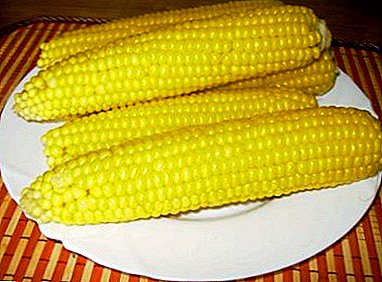 In the conditions of lack of space in the summer cottage, sometimes you have to think about keeping several species of domestic animals (poultry, small and large livestock) in one territory. Some animals are able to get along together, but there are those that are absolutely impossible to settle near. Can we keep together chickens and rabbits, what are the features of such content, and what are the pros and cons of living together these animals - we consider in more detail.
In the conditions of lack of space in the summer cottage, sometimes you have to think about keeping several species of domestic animals (poultry, small and large livestock) in one territory. Some animals are able to get along together, but there are those that are absolutely impossible to settle near. Can we keep together chickens and rabbits, what are the features of such content, and what are the pros and cons of living together these animals - we consider in more detail.
Content Features
Of course, for the comfortable existence of pets, it is desirable for each individual species to have its own territory - this helps to preserve the sense of security in animals and their calmness.
Important! Far from all breeds of rabbits can be kept year-round in the open air: during severe frosts, most of them need additional heating - for this they are transferred to special heated cages or sheds.Before deciding whether rabbits and chickens can coexist together, it is important to consider the peculiarities of the content of each type of pet. Below is a comparative table that clearly demonstrates the key points of keeping rabbits and chickens.

| Rabbits | Chickens |
|
|

Differences:
- Rabbits are by their nature quite peaceful creatures that do not show aggression and alternate active pastime with a peaceful rest in the shade. But the way of life of chickens is very active: they are constantly in motion, looking for food or just taking walks under the rays of the sun.
- If chickens like to dig in the dust and do not feel cramped in conditions of limited movement, then for eared animals such an environment is accompanied by stress and even diseases.
Learn how to keep ducks and chickens together.
- The rations are different for these pets: there is boiled food in the layers menu: potatoes, boiled corn and some porridges, but such food is contraindicated for rabbits.
- The temperature conditions for rabbits and chickens also differ: if the house must be insulated for winter, then some cold-resistant eared breeds (New Zealand White, Burgundy, Californian, etc.) begin to feel ill when the temperature is too high for them - additional warming is not required for them .
- Common to rabbits and chickens is the possibility of movement: both layers and eared animals like to walk in open space. But if chickens are restricted in their movement, then in eared ones this will cause serious discomfort.
- Both of these types of domestic animals need a separate resting place: for rabbits, this is a small house for midday sleep, and for laying hens a well-equipped pen for the night.
- Despite the fact that the hens are not demanding cleanliness, cleaning the house, troughs and drinkers are also mandatory: bacteria that multiply in food debris are the causative agents of some intestinal diseases (heterocidosis, worms, salmonellosis, etc.).
It will be interesting for you to read about how to determine the sex of the rabbit, what they eat and how to feed the rabbits in winter, when you can allow the rabbit to be mated, as well as how long it lasts and how to determine the suckeness of the rabbit.As you can see, rabbits and chickens have their own specific features that must be taken into account when keeping these pets.

Positive and problematic issues
The content of rabbits and chickens has both positive and negative factors. Despite the fact that these animals have a lot of differences, some of the problems for their care remain similar.
Rabbits
The main value of these eared animals lies in their fur and meat.
Familiarize yourself with the nuances of breeding rabbits such as Rex, Californian, Butterfly, White Giant, Baran, Black-Brown, Risen, Belgian Giant, Gray Giant, Soviet Chinchilla.
In addition, the positive factors of their content and breeding are:
- rapid reproduction;
- unpretentiousness in food;
- high profitability of rabbit breeding;
- animal cleanliness;
- hypoallergenic rabbit fur;
- the possibility of animal training;
- no need for compulsory vaccination of the animal.

Negative factors of the content of baby rabbits include:
- the need for large quantities of food;
- special requirements for the hygienic conditions of the cage, feeders and drinkers;
- the need for a large space for walking;
- sensitivity to drafts, as a result - frequent morbidity;
- poor tolerance of too high or too low temperatures, as well as excessive humidity or dry air;
- incompatibility with most domestic animals (cats, dogs, turkeys, geese and cattle);
- weak stomach, a tendency to overeating;
- aggressiveness in keeping two males together;
Important! Rabbits can die of fright - as a result of too loud sound or the appearance of aggressive unfamiliar animal (especially large size), the crawl can experience a heart attack, which can be fatal.
- eating your own feces (for some hosts it has an anti-aesthetic effect).
Chickens
The content of the chickens are such positive points:
- the use of chicken and eggs in the food and industrial industries;
- ease of care;
- the rapid growth of chicks;
- unpretentiousness to food;
It will be useful for poultry farmers to read about whether a rooster is needed for chickens to carry eggs, why chickens peck each other up to blood, how many chickens there should be for one rooster, when chickens start to rush, what to do if chickens do not like it, how to wean the eggs to hatch eggs how to feed chickens grass.
- possibility of keeping with other poultry (geese, ducks, turkeys);
- thrift content;
- the possibility of cellular content;
- undemanding to have a large space;
- obtaining natural fertilizer from chicken manure.

The main negative factors of keeping and breeding chickens are:
- requirements for good lighting and insulation in winter;
- the need for regular, frequent feeding and constant supervision;
- frequent morbidity;
- the need for a special fence that protects ornamental plants.
Did you know? On average, one day the rabbit is applied to the trough more than 100 times - even if he is full, he still needs to chew on something or just move his jaws. In this case, a little rabbit weighing 2 kilograms can drink as much water as a ten-kilogram dog per day.Thus, similar problems of keeping rabbits and chickens are the need for large quantities of balanced food, susceptibility to diseases and demands on conditions of detention.
Video: features of the content of chickens
Conclusions: Is it Possible to Keep Chickens and Rabbits Together?
Based on the above points, we can summarize: keeping chickens and rabbits together is really undesirable.
- These completely different pets have a diametrically opposite disposition: rabbits love calm, while the chicken rarely sits still.
- In addition, the diet of these animals is different: some food of chickens can be deadly for rabbits (for example, boiled porridge causes constipation and sour food in the stomach, which can lead to severe poisoning of animals).
- Rabbits need to be protected from sharp objects, while for chickens the presence of hard stones is an important factor of maintenance.
- In addition, some diseases of poultry can go on rabbits, and vice versa - and not to mention the different demands on hygienic standards and temperature regimes: overheating and the presence of drafts can be disastrous for rabbits, while the chicken can die from cold temperatures which for rabbit is perfectly acceptable.
 As you can see, there are many negative aspects of the coexistence of these pets, and a positive factor can only be called the saving of space.
As you can see, there are many negative aspects of the coexistence of these pets, and a positive factor can only be called the saving of space.Keeping chickens and rabbits together
In cases where there is no possibility to keep rabbits separately and chickens, you should ensure the most comfortable conditions for each “neighbor”:
- select and protect a separate area for meals. Rabbits should not have access to the bird feeder, and vice versa;
- take care of acceptable temperature conditions: eliminate the possibility of drafts, prevent overheating and excessive cooling of the enclosure;
- allocate an individual place to sleep: rabbits should have their own nook for resting, and the bird should be sent overnight to a special closed enclosure;
- exclude the cohabitation of two males of rabbits together: in this case not only chickens will suffer and will be bitten, but also fluffy animals themselves;
- no more than a dozen chickens should fall on 2 rabbits - otherwise the rabbits will become irritable, lose sleep and appetite, show aggression.
In any case, cohabitation of rabbits and chickens will cause inconvenience: such a neighborhood will annoy animals, frighten and violate their natural behavior. It is best to keep these pets apart, and only if absolutely necessary, taking into account all the nuances and subtleties of the content, it is possible to combine the pastime of these animals.
Did you know? The largest breed of chickens in the world is Brama. The average weight of one layer of this breed reaches 5 kg, and the average egg production is about 250 eggs per year. The largest rooster in the world also belongs to this breed: its weight is 11 kg and its height is 91 cm at the withers. This giant lives in Somerset (United Kingdom) and is famous for driving wild foxes alone from its hen house.
Try to create maximum comfort for the animals, taking into account all the recommendations given, it is possible to ensure a completely tolerable coexistence for domestic rabbits and poultry.
Reviews from the network














